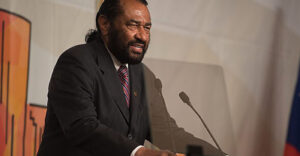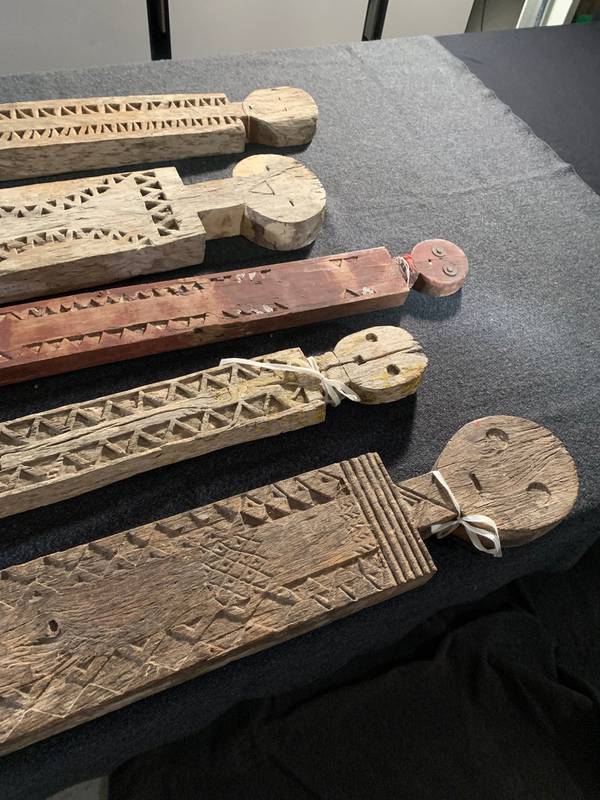Curators at the Illinois State Museum say they don’t know exactly how 38 wooden sculptures made their way from Kenya to Springfield. But the leading theory is that the move wasn’t aboveboard.
“We can’t demonstrably state these in particular were stolen, but all the circumstantial evidence sort of points to that,” said Brooke Morgan, the curator of anthropology at the state museum system, a consortium of four museums around Illinois.
Known as vigango, the statues are life-size wooden planks with carved heads with intricately painted faces. The Mijikenda people of coastal Kenya make the vigango to represent the souls of deceased elders in their community and plant the planks in the ground so community members and loved ones can gather to speak to their dead ancestors.
If vigango are moved far from their relatives, they lose their powers, according to the website of art collector and historian Ernie Wolfe.
The Illinois State Museum acquired 38 vigango sculptures in 2001. Five years later, the museum returned one of the sculptures after it was traced back to an original family member and determined to have been stolen.
Beginning in 2018, Morgan took part in discussions about the statues with the Mijikenda, art experts, the National Museums of Kenya and leaders of art museums around the country.
It became clear to experts that while it’s difficult to trace exactly how the vigango wound up in U.S. museums, the statues were not likely to have been obtained in an ethical fashion since their spiritual significance make it unlikely the Mijikenda would have engaged in wholesale sale or trade.
So earlier this month, the Illinois State Museum announced it had returned its remaining 37 statues to Kenya.
“Not all items do belong in a museum,” Morgan said.
The vigangos’ “natural life is supposed to be to decay where they are put in place,” she said. “We are kind of imposing our Western view of art or cultural materials onto these items.”
In recent years, museums around the world have been reconsidering the ethics of how items in their collections were sourced, and in some cases returning items that are suspected to have been stolen or are deemed sacred to the country of origin.
The Illinois State Museum is not the only institution that has reconsidered its collection of vigango statues. In 2020 the Denver Museum of Nature & Science shipped dozens of its vigango back to the Mijikenda.
The issue involving the vigango is not the first time the Illinois State Museum has had to confront controversial holdings in its collection.
In 2019, the museum returned dozens of artifacts to two Aboriginal Australian communities after many were determined to be sacred. And it continues to face questions about its handling of Native American remains.
In January, ProPublica reported that one of the state museums is built on a massive Native American gravesite, and that the museums have “the country’s second-largest collection of unrepatriated Native American remains, and one of the lowest return rates” of these artifacts. In response, the museum said the data ProPublica cited was outdated and that it continues efforts to repatriate remains.
Three decades ago, Congress passed the Native American Graves Protection and Repatriation Act, which the National Park Service website says “acknowledged that human remains and other cultural items removed from Federal or tribal lands belong, in the first instance, to lineal descendants, Indian Tribes, and Native Hawaiian organizations.”
One challenge universities and museums in Illinois say they face is that there are no federally recognized reservations in the state, and those reservations are where Native human remains are often returned, said Democratic state Rep. Mark Walker of Arlington Heights, who this spring sponsored legislation that attempts to address the issue.
In making the argument for his bill, Walker referenced the Cherokee Indians who died in Illinois on what’s known as the Trail of Tears.
“Take the Cherokee remains given back to the Cherokee tribe in Oklahoma,” Walker said on the House floor in May. “A member of that nation told me ‘It’s like redoing the Trail of Tears where not only did you force us out of the Midwest and into Oklahoma but you’re going to force us to move our bones there as well.’”
Walker’s legislation, which passed through the Illinois House and Senate without any no votes, would do two things supporters say would help facilitate the return of many Native human remains.
First, the measure would allow the Illinois Department of Natural Resources to create burial sites on IDNR land “for the reburial of repatriated Native American human remains” after consultation with Native tribes. That would expand where Native human remains can be laid to rest by allowing them to stay on nontribal lands if the tribes agree.
Second, the bill would require IDNR to expedite the remaining removal and transfer process.
“By bringing this bill forward we will finally be able to treat these folks with the dignity that they deserve,” said deputy Republican leader Rep. Norine K. Hammond of McDonough County during the floor debate before the House’s vote.
Gov. J.B. Pritzker is reviewing the legislation, his office said.
In 2021, the Illinois State Museum co-hosted a nationwide museum industry-led discussion on returning objects.
“The Illinois State Museum is working to be a trusted partner to Indigenous communities worldwide through our repatriation efforts and beyond,” the museum’s former director, Cinnamon Catlin-Legutko, said in April 2021.
The National Museums of Kenya is working with the Illinois State Museum to facilitate the delivery of its vigango collection back to their communities, although they may not end up back in the ground, because the Mijikenda has expressed concern about them being stolen yet again. A spokesperson for the Kenya museum could not be reached.
Morgan left for Kenya on July 8, joined by representatives from other United States museums and universities to meet with Mijikenda elders and other groups affected by the art trade.
For museums, figuring out which objects to return is often difficult because ownership records are often muddled or nonexistent.
The vigango statues met the criteria for objects that should be returned because of the possibly unethical nature of how they were brought to Illinois and also because of their spiritual importance to the people who created them.
“It’s not like we’ve flung the doors open like ‘come and get it,’” Morgan said. “But … if these are things that are sacred and are needed by people to practice their religious beliefs, that’s certainly something that we can understand,. Each case is going to be different. … It’s not an automatic ‘yes’ from us.”







